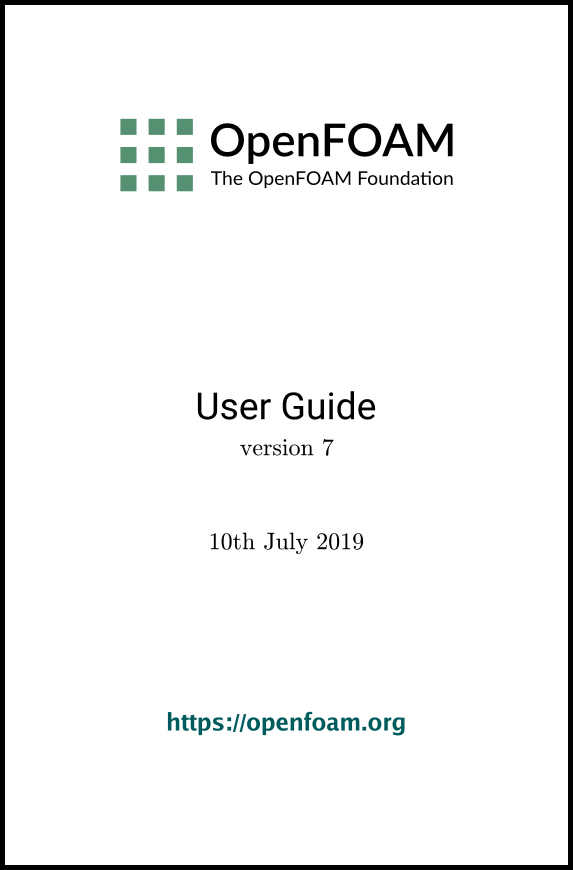[version 13][version 12][version 11][version 10][version 9][version 8][version 7][version 6]
The OpenFOAM User Guide provides an introduction to OpenFOAM, through some basic tutorials, and some
details about the general operation of OpenFOAM.
OpenFOAM is a collection of approximately 250
applications built upon a collection of over 100 software libraries (modules). Each application
performs a specific task within a CFD workflow. The snappyHexMesh application, for example, is a mesh generator for
complex geometry, which can generate a mesh around a vehicle. The simpleFoam application could then
simulate steady-state, turbulent, incompressible flow around the vehicle. Alternatively, the pimpleFoam application could run a transient simulation. The OpenFOAM
User Guide describes these applications and how to execute them, either on a single processor or in
parallel on multiple processors.
Case Setup
The OpenFOAM User Guide then examines the set up of input data files for a CFD analysis. The input data includes time information (start time, end time, time step, etc) and controls for reading and writing data (time, format, compression, etc). It additionally describes the setting of numerical schemes that affects accuracy and stability of a simulation. Matrix solver controls and algorithm controls are also explained that affect computational time and stability.
Meshing
The OpenFOAM User Guide includes a chapter on meshing. It begins with the mesh structure of OpenFOAM and the handling of boundaries and boundary conditions. It describes the blockMesh application for generating meshes of simple geometries in detail, followed by the snappyHexMesh application and its control parameters. OpenFOAM includes applications that convert meshes from well known formats into the OpenFOAM format and detailed the User Guide covers principal conversion applications, e.g. fluentMeshToFoam, in detail. The mapFields application maps field data, e.g. pressure, velocity, from one mesh/geometry to another.
Post-Processing
OpenFOAM is shipped with a version of ParaView that includes a reader module to read data in OpenFOAM format. This enables visualization of solutions from OpenFOAM, with elements used commonly in CFD such as geometry surfaces, cutting planes, vector plots and streamlines. With these elements, users can generate animations conveniently with ParaView.
Case Setup
The OpenFOAM User Guide then examines the set up of input data files for a CFD analysis. The input data includes time information (start time, end time, time step, etc) and controls for reading and writing data (time, format, compression, etc). It additionally describes the setting of numerical schemes that affects accuracy and stability of a simulation. Matrix solver controls and algorithm controls are also explained that affect computational time and stability.
Meshing
The OpenFOAM User Guide includes a chapter on meshing. It begins with the mesh structure of OpenFOAM and the handling of boundaries and boundary conditions. It describes the blockMesh application for generating meshes of simple geometries in detail, followed by the snappyHexMesh application and its control parameters. OpenFOAM includes applications that convert meshes from well known formats into the OpenFOAM format and detailed the User Guide covers principal conversion applications, e.g. fluentMeshToFoam, in detail. The mapFields application maps field data, e.g. pressure, velocity, from one mesh/geometry to another.
Post-Processing
OpenFOAM is shipped with a version of ParaView that includes a reader module to read data in OpenFOAM format. This enables visualization of solutions from OpenFOAM, with elements used commonly in CFD such as geometry surfaces, cutting planes, vector plots and streamlines. With these elements, users can generate animations conveniently with ParaView.
Contents
1 Introduction
2 Tutorials
2.1 Lid-driven cavity flow
2.2 Stress analysis of a plate with a hole
2.3 Breaking of a dam
3 Applications and libraries
3.1 The programming language of OpenFOAM
3.2 Compiling applications and libraries
3.3 Running applications
3.4 Running applications in parallel
3.5 Standard solvers
3.6 Standard utilities
4 OpenFOAM cases
4.1 File structure of OpenFOAM cases
4.2 Basic input/output file format
4.3 Global controls
4.4 Time and data input/output control
4.5 Numerical schemes
4.6 Solution and algorithm control
4.7 Case management tools
5 Mesh generation and conversion
5.1 Mesh description
5.2 Boundaries
5.3 Mesh generation with the blockMesh utility
5.4 Mesh generation with the snappyHexMesh utility
5.5 Mesh conversion
5.6 Mapping fields between different geometries
6 Post-processing
6.1 ParaView/paraFoam graphical user interface (GUI)
6.2 Post-processing command line interface (CLI)
6.3 Sampling and monitoring data
6.4 Third-Party post-processing
7 Models and physical properties
7.1 Thermophysical models
7.2 Turbulence models
7.3 Transport/rheology models
Index
1 Introduction
2 Tutorials
2.1 Lid-driven cavity flow
2.2 Stress analysis of a plate with a hole
2.3 Breaking of a dam
3 Applications and libraries
3.1 The programming language of OpenFOAM
3.2 Compiling applications and libraries
3.3 Running applications
3.4 Running applications in parallel
3.5 Standard solvers
3.6 Standard utilities
4 OpenFOAM cases
4.1 File structure of OpenFOAM cases
4.2 Basic input/output file format
4.3 Global controls
4.4 Time and data input/output control
4.5 Numerical schemes
4.6 Solution and algorithm control
4.7 Case management tools
5 Mesh generation and conversion
5.1 Mesh description
5.2 Boundaries
5.3 Mesh generation with the blockMesh utility
5.4 Mesh generation with the snappyHexMesh utility
5.5 Mesh conversion
5.6 Mapping fields between different geometries
6 Post-processing
6.1 ParaView/paraFoam graphical user interface (GUI)
6.2 Post-processing command line interface (CLI)
6.3 Sampling and monitoring data
6.4 Third-Party post-processing
7 Models and physical properties
7.1 Thermophysical models
7.2 Turbulence models
7.3 Transport/rheology models
Index
@book
{
greenshields2019,
title = "OpenFOAM v7 User Guide",
author = "Greenshields, Christopher",
year = 2019,
url = "https://doc.cfd.direct/openfoam/user-guide-v7",
publisher = "The OpenFOAM Foundation",
address = "London, UK"
}
OpenFOAM v7 User Guide

